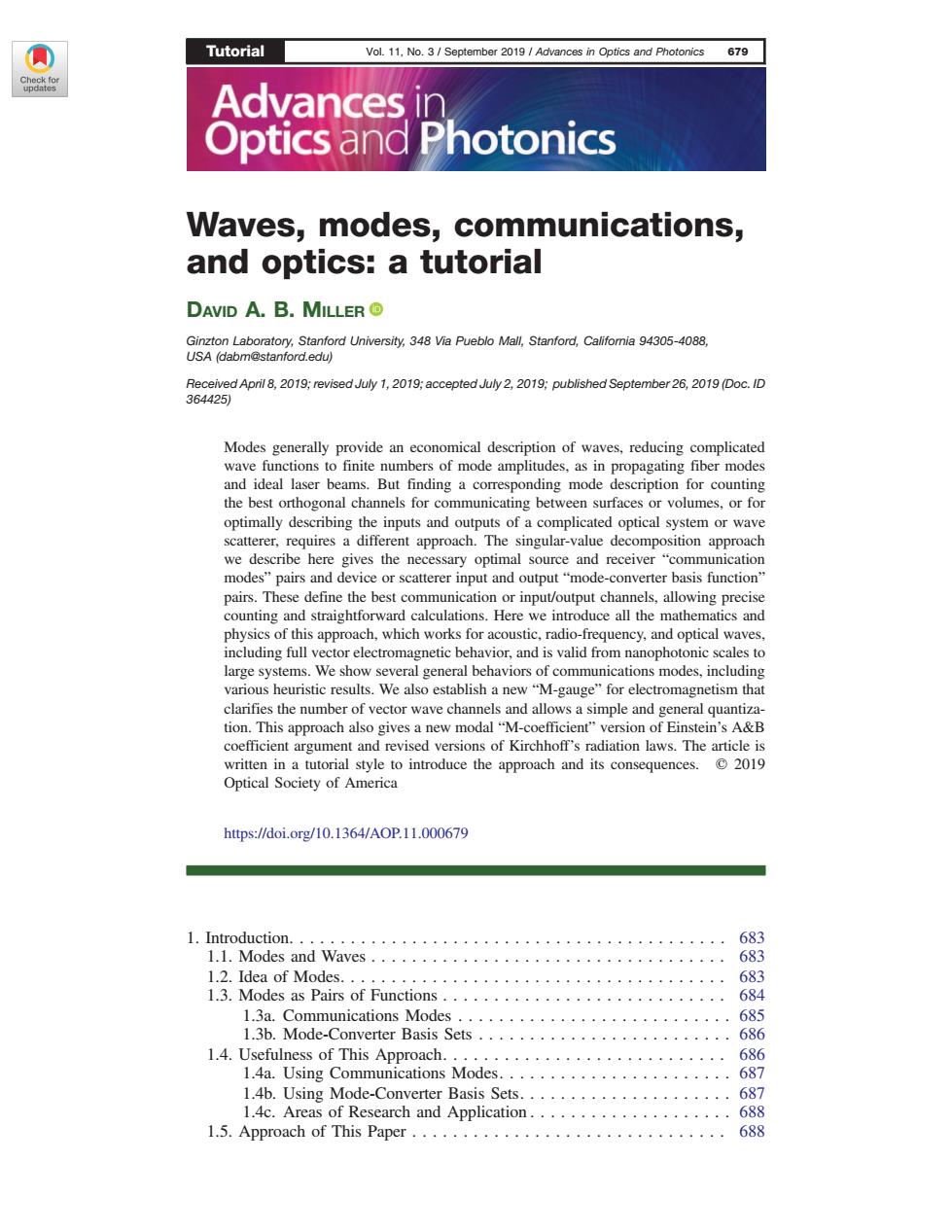正在加载图片...

Tutorial Vol.11,No.3/September 2019 Advances in Optics and Photonics 679 Advances n Optics and Photonics Waves,modes,communications, and optics:a tutorial DAVID A.B.MILLER Ginzton Laboratory,Stanford University,348 Via Pueblo Mall,Stanford,California 94305-4088, USA (dabm@stanford.edu) Received April 8,2019;revised July 1,2019;accepted July 2,2019;published September26,2019(Doc.ID 364425) Modes generally provide an economical description of waves,reducing complicated wave functions to finite numbers of mode amplitudes,as in propagating fiber modes and ideal laser beams.But finding a corresponding mode description for counting the best orthogonal channels for communicating between surfaces or volumes,or for optimally describing the inputs and outputs of a complicated optical system or wave scatterer,requires a different approach.The singular-value decomposition approach we describe here gives the necessary optimal source and receiver "communication modes"pairs and device or scatterer input and output"mode-converter basis function" pairs.These define the best communication or input/output channels,allowing precise counting and straightforward calculations.Here we introduce all the mathematics and physics of this approach,which works for acoustic,radio-frequency,and optical waves. including full vector electromagnetic behavior,and is valid from nanophotonic scales to large systems.We show several general behaviors of communications modes,including various heuristic results.We also establish a new"M-gauge"for electromagnetism that clarifies the number of vector wave channels and allows a simple and general quantiza- tion.This approach also gives a new modal "M-coefficient"version of Einstein's A&B coefficient argument and revised versions of Kirchhoff's radiation laws.The article is written in a tutorial style to introduce the approach and its consequences.2019 Optical Society of America https://doi.org/10.1364/AOP.11.000679 1.ntroduction.··········…··· 683 l.l.Modes and Waves......········… 683 l.2.Idea of Modes......·...····················… 683 l.3.Modes as Pairs of Functions..··················· 684 1.3a.Communications Modes 685 1.3b.Mode-Converter Basis Sets 686 l.4.Usefulness of This Approach.···.· 686 1.4a.Using Communications Modes.. 687 1.4b.Using Mode-Converter Basis Sets.. 687 l.4c.Areas of Research and Application.............···· 688 l.5.Approach of This Paper,..·..·...··.········ 688Waves, modes, communications, and optics: a tutorial DAVID A. B. MILLER Ginzton Laboratory, Stanford University, 348 Via Pueblo Mall, Stanford, California 94305-4088, USA (dabm@stanford.edu) Received April 8, 2019; revised July 1, 2019; accepted July 2, 2019; published September 26, 2019 (Doc. ID 364425) Modes generally provide an economical description of waves, reducing complicated wave functions to finite numbers of mode amplitudes, as in propagating fiber modes and ideal laser beams. But finding a corresponding mode description for counting the best orthogonal channels for communicating between surfaces or volumes, or for optimally describing the inputs and outputs of a complicated optical system or wave scatterer, requires a different approach. The singular-value decomposition approach we describe here gives the necessary optimal source and receiver “communication modes” pairs and device or scatterer input and output “mode-converter basis function” pairs. These define the best communication or input/output channels, allowing precise counting and straightforward calculations. Here we introduce all the mathematics and physics of this approach, which works for acoustic, radio-frequency, and optical waves, including full vector electromagnetic behavior, and is valid from nanophotonic scales to large systems. We show several general behaviors of communications modes, including various heuristic results. We also establish a new “M-gauge” for electromagnetism that clarifies the number of vector wave channels and allows a simple and general quantization. This approach also gives a new modal “M-coefficient” version of Einstein’s A&B coefficient argument and revised versions of Kirchhoff’s radiation laws. The article is written in a tutorial style to introduce the approach and its consequences. © 2019 Optical Society of America https://doi.org/10.1364/AOP.11.000679 1. Introduction. . . . . . . . . . . . . . . . . . . . . . . . . . . . . . . . . . . . . . . . . . . 683 1.1. Modes and Waves . . . . . . . . . . . . . . . . . . . . . . . . . . . . . . . . . . . 683 1.2. Idea of Modes. . . . . . . . . . . . . . . . . . . . . . . . . . . . . . . . . . . . . . 683 1.3. Modes as Pairs of Functions . . . . . . . . . . . . . . . . . . . . . . . . . . . . 684 1.3a. Communications Modes . . . . . . . . . . . . . . . . . . . . . . . . . . . 685 1.3b. Mode-Converter Basis Sets . . . . . . . . . . . . . . . . . . . . . . . . . 686 1.4. Usefulness of This Approach. . . . . . . . . . . . . . . . . . . . . . . . . . . . 686 1.4a. Using Communications Modes. . . . . . . . . . . . . . . . . . . . . . . 687 1.4b. Using Mode-Converter Basis Sets. . . . . . . . . . . . . . . . . . . . . 687 1.4c. Areas of Research and Application . . . . . . . . . . . . . . . . . . . . 688 1.5. Approach of This Paper . . . . . . . . . . . . . . . . . . . . . . . . . . . . . . . 688 Tutorial Vol. 11, No. 3 / September 2019 / Advances in Optics and Photonics 679